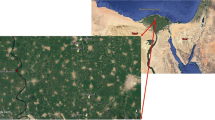Abstract
Water quality of the Gomti River and phytoremediation potential of native macrophytes dwelling therein at six different sites were evaluated. River water showed high biochemical oxygen demand, chemical oxygen demand, nitrate, ammonium and phosphate (12.84, 77.94, 36.88, 6.04 and 2.25 mg L−1, respectively). Gomti water was found to be contaminated with different metals like Fe, Cd, Cu, Cr and Pb (5.54, 1.05, 3.74, 2.57 and 0.73 mg L−1, respectively). Macrophytes growing in the river accumulated considerable amounts of Fe, Cd, Cu, Cr and Pb in different parts. Among the studied plants, Eichhornia crassipes showed maximum remediation potential for Fe, Cd and Pb; Jussiaea repens for Cr; and Pistia stratiotes for Cd. However, in Typha latifolia, Cu accumulation was maximum. Except for Fe, translocation factor of E. crassipes, P. stratiotes, Hydrilla verticellata and T. latifolia was >1 for the studied metals, showing their potential to accumulate multiple metals in different plant parts.


Similar content being viewed by others
References
Agarwal R, Kumar R, Behari JR (2007) Mercury and lead content fish species from the river Gomti, Lucknow, India, as biomarker of contamination. Bull Environ Contam Toxicol 78:118–122
Ahmad SS, Reshi ZA, Shah MA, Rashid I, Ara R, Andrabi SMA (2014) Phytoremediation potential of Phragmites australis in Hokersar wetland—a Ramsar site of Kashmir Himalaya. Int J Phytoremediation 16:1183–1191
Allen SE (1989) Analysis of ecological materials, 2nd edn. Blackwell, Oxford
APHA (American Public Health Association) (2005) Standard methods for the examination of water and wastewater, 21st edn. Washington, DC
Baker AJM, Brooks RR (1989) Terrestrial higher plants which hyperaccumulate metallic elements. A review of their distribution, ecology and phytochemistry. Biorecovery 1:81–126
Bauddh K, Singh RP (2012) Cadmium tolerance and its phytoremediation by two oil yielding plants Ricinus communis (L.) and Brassica juncea (L.) from the contaminated soil. Int J Phytoremediation 14:772–785
Bellos D, Sawidis T (2005) Chemical pollution monitoring of the river pinios (Thessalia—Greece). J Environ Manage 76:282–292
Cardwell A, Hawker D, Greenway M (2002) Metal accumulation in aquatic macrophytes from southeast Queensland, Australia. Chemosphere 48:653–663
Chiranjeevi P, Chandra R, Mohan SV (2013) Ecologically engineered submerged and emergent macrophyte based system: an integrated eco-electrogenic design for harnessing power with simultaneous wastewater treatment. Ecol Eng 51:181–190
EPA (2009) Drinking water contaminants: National Primary Drinking Water Regulations. Specific fact sheets for consumer. http://water.epa.gov/drink/contaminants/
Fawzy MA, El-Sayed Badr N, El-Khatib A, Abo-El-Kassem A (2012) Heavy metal biomonitoring and phytoremediation potentialities of aquatic macrophytes in River Nile. Environ Monit Assess 184:1753–1771
Ishaq F, Khan A (2013) Heavy metal analysis of river Yamuna and their relation with some physicochemical parameters. Glob J Environ Res 7(2):34–39
Jarup L (2003) Hazards of heavy metal contamination. Br Med Bull 68:167–182
Johri N, Jacquillet G, Unwin R (2010) Heavy metal poisoning the effects of cadmium on the kidney. Biometals 23:783–792
Khan S, Ahmad I, Shah MT, Rehman S, Khaliq A (2009) Use of constructed wetland for the removal of heavy metals from industrial wastewater. J Environ Manage 90:3451–3457
Lohani MB, Singh A, Rupainwar DC, Dhar DN (2008) Seasonal variations of heavy metal contamination in river Gomti of Lucknow city region. Environ Monit Assess 147:253–263
Padmavathiamma PK, Li LY (2007) Phytoremediation technology: hyperaccumulation of metals in plants. Water Air Soil Pollut 184:105–126
Rahman MA, Hasegawa H (2011) Aquatic arsenic: phytoremediation using floating macrophytes. Chemosphere 83:633–646
Rai PK (2010) Phytoremediation of heavy metals in a tropical impoundment of industrial region. Environ Monit Assess 165:529–537
Rai PK, Tripathi BD (2009) Comparative assessment of Azolla pinnata and Vallisneria spiralis in Hg removal from G.B. Pant Sagar of Singrauli Industrial region, India. Environ Monit Assess 148:75–84
Rai UN, Prasad D, Verma S, Upadhyay AK, Singh NK (2012) Biomonitoring of metals in ganga water at different ghats of haridwar: implications of constructed wetland for sewage detoxification. Bull Environ Contam Toxicol 89:805–810
Sekomo CB, Nkuranga E, Rousseau PLD, Lens PNL (2011) Fate of heavy metals in an urban natural wetland: the Nyabugogo swamp (Rwanda). Water Air Soil Pollut 214:321–333
Shuvaeva OV, Belchenko LA, Romanova TE (2013) Studies on cadmium accumulation by some selected floating macrophytes. Int J Phytoremediation 15:979–990
Souza FA, Dziedzic M, Cubas AS, Maranho LT (2013) Restoration of polluted waters by phytoremediation using Myriophyllum aquaticum (Vell.) Verdc., Haloragaceae. J Environ Manage 120:5–9
Srivastava S, Shrivastava M, Suprassana P, Dsouza SF (2011) Phytofiltration of arsenic from simulated contaminated water using Hydrilla verticellata in field conditions. Ecol Eng 37:1937–1941
Sun L, Liao X, Yan X, Zhu G, Ma D (2014) Evaluation of heavy metal and polycyclic aromatic hydrocarbons accumulation in plants from typical industrial sites: potential candidate in phytoremediation for co-contamination. Environ Sci Pollut Res 21(21):12494–12504
Vardanyan LG, Ingole B (2006) Studies on heavy metal accumulation in aquatic macrophytes from Sevan (Armenia) and Carambolim (India) lake systems. Environ Int 32:208–218
Vesely T, Tlustos P, Szakova J (2011) The use of water lettuce (Pistia stratiotes L.) for rhizofiltration of a highly polluted solution by cadmium and lead. Int J Phytoremediation 13:859–872
Weis JS, Weis P (2004) Metal uptake, transport and release by wetland plants: implications for phytoremediation and restoration. Environ Int 30:685–700
Author information
Authors and Affiliations
Corresponding author
Rights and permissions
About this article
Cite this article
Shah, A.B., Rai, U.N. & Singh, R.P. Correlations Between Some Hazardous Inorganic Pollutants in the Gomti River and Their Accumulation in Selected Macrophytes Under Aquatic Ecosystem. Bull Environ Contam Toxicol 94, 783–790 (2015). https://doi.org/10.1007/s00128-015-1546-0
Received:
Accepted:
Published:
Issue Date:
DOI: https://doi.org/10.1007/s00128-015-1546-0




